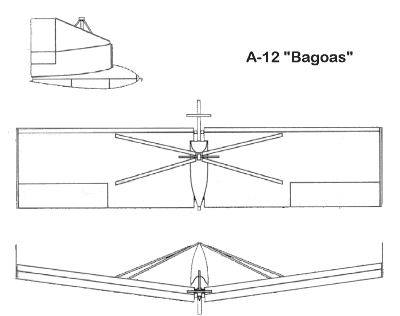| http://www.survol.cjb.net |
Abrial A-12 / A-13

One of the airfoil
sections designed by Georges Abrial for tailless
aircraft.
Georges Abrial was born in 1898; in the year 1909 he started to build scale model gliders and became an expert in that field (he built more than 250 models). Graduated from the St Cyr Aeronautical Institute he became an aerodynamicist for the Levasseur firm. His first full-size glider was the Levasseur-Abrial A-1 in 1922, it was destroyed on its fourth take-off. This glider was followed by another one, the A-2 "Vautour", then the Peyret-Abrial "Rapace", designed with the assistance of Louis Peyret and Professor Toussaint. The "Rapace" beat the international altitude record with 720 m. In 1927, Abrial built a two-seater airplane powered by a 40 hp engine, the A-3 "Oricou".
But all these aircraft had conventional lines, and as an aerodynamicist, Georges Abrial was very interested in the flying wing formula. He tested several scale models, various airfoils, and eventually designed for the Caudron company a tailless airplane , the A-260, extrapolated from a Caudron C-260. But his main interest was soaring, so he decided to design a tailless glider : the A-12. After testing successfully a scale model at the St Cyr wind tunnel, he built the full-size prototype. This unconventional glider had an aspect ratio of only 6. During the development of this new glider, in 1932, Georges Abrial had to face so much technical difficulties that he decided to give up the project. He christened his project "Bagoas", the name of a famous Persian poisoner !
But his work was re-used by other designers. Charles Fauvel modified an Abrial airfoil section for his projects (the Abrial / STAé 230-231, thickened to 17%) and Georges Abrial helped him for the development of his AV-2. The Abrial reflex airfoils were very efficient and the various tests at the St Cyr wind tunnel gave enough data to use them successfully for tailless aircraft. In 1954, Al Backstrom used also a modified Abrial section for his EPB-1 "Flying Plank".
Abrial stopped designing new aircraft after 1932, he was more attracted by instructorship and educational methods and played an important role in the development of soaring in France during the thirties. After the war he was still very active in promoting soaring not only in France, but also in French Africa.
In 1954 he came back to the design of tailless aircraft, with the A-13 "Buse" project. But this glider was never built.
